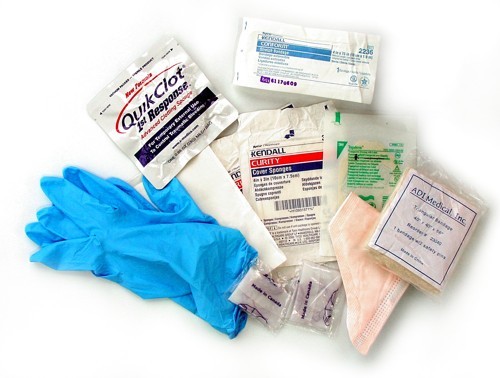As with anything in gear, configuring a medkit is a compromise. If you had everything you could possibly want, you'd be carrying a Level 1 Trauma center and an ICU. If you only carry a band-aid and an Aspirin, you're not prepared for much. With this in mind, what I have here is intended to get you thinking about what you should carry, not prescribing what that is. What you should carry and what I should carry may not be the same for many reasons. It's easy to carry too much and too many people carry nothing. There are hundreds of websites and forum threads that discuss what to carry. Some are good, some are dangerously bad. Make sure you get educated advice that fits your skills and environment. Finally, don't get caught up in "sexy" gear and forget the stuff you actually would use.
Let's start with some questions:
- What is this medkit for?
- What am I trained to do?
- How will I carry it?
What is this medkit for?
Think about the situation you're preparing for. Gunshot wound? Training injuries like sprains/strains? General first aid issues that come up in any activity, including shooting sports? Providing full medical support to dynamic entry training? You get the point.
When I'm going to the range, I have three different "medkits". While there is some redundancy, each is for something different. I have my "blowout kit", which is clearly marked and attached to my range bag for immediate penetrating trauma emergencies. I have my "snivel kit" which has band-aids, aspirin, antiseptic wipes and such for everyday minor medical issues (which is in a small ziplock bag and fits in a pocket in the range bag). Finally, as a former medical provider, I have a much larger, more comprehensive kit in my car that encompasses the above items and more advanced/diagnostic care. Why do I mention that? Because each one was born from a different need, and carried/stored according to that need. So ask yourself - what am I trying to prepare for?
What am I trained to do?
This is pretty straightforward. Know your skills, your limitations, and the laws. Be careful with carrying advanced life support gear or medications if you're not certified to use them where you live, even if you know how. The caveat to that, however: Even if you don't have the training, there's still value in having basic emergency supplies with you for the other guy at the range who knows how, but isn't prepared. There are many places to get basic first aid training, and even occasionally ones tailored to recreational shooters. If you don't have any medical knowledge and plan to make a serious hobby of shooting, it's a good investment.
How will I carry it?
Do you want to carry a separate emergency bag? If so, will that always be with you or start getting left behind when you have other gear to manage? How much space do you have? This depends on so many factors that I won't try to prescribe something here, but I'll make this suggestion: If you're carrying trauma/"blowout" gear, it's helpful to have it in a clearly marked kit that attaches to your normal range gear and can be easily found and removed by someone unfamiliar with your kit in an emergency.
My only firm recommendation here is this: Don't get caught up in having "just the right gear" and either feel like you have to spend a ton of money or end up getting nothing. Have something with you, even if it's just a couple of triangular bandages and a pair of nitrile gloves in a ziplock in your range bag. Just those tools alone can handle a surprising number of emergencies and may be just what someone needs.... right now. Remember, the life you save may be your own.
Finally, I am neither a doctor nor a lawyer and I didn't stay in a Holiday Inn Express last night. That's my way of reminding you that medical care, like shooting, is serious business and you are responsible for the choices you make.







 Reply With Quote
Reply With Quote


